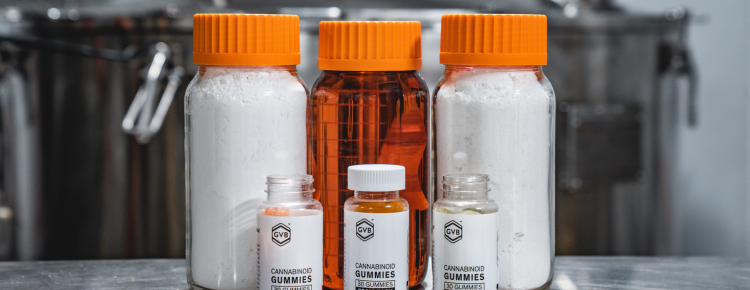If you only consider cannabinoids when unraveling the mysteries of cannabis, you’re only looking at one side of the puzzle. Just as important are terpenes — far more volatile, but also vastly more aromatic than cannabinoids. Terpenes may be more like cannabinoids than we give them credit for, though: Find out exactly what terpenes are and compare the most popular terpenes in this guide.
What are terpenes?
Terpenes are volatile, aromatic compounds found in Cannabis sativa and a variety of other plant species throughout nature. In fact, you’d be hard-pressed to find any plant that does not contain any terpenes at all. These compounds are among the primary flavoring and aromatic agents used in nature, and in cannabis, they’re responsible for the delectable bouquet that accompanies each distinct strain.
Where do terpenes come from?
Terpenes naturally emerge during the maturation process in many plants. The moment that a plant begins to give off an aroma during maturation, it’s likely that terpenes are beginning to develop.
Even common flavors in herbs are present due to the presence of terpenes. Mint leaves taste minty, for instance, due to the presence of menthol — a terpene¹.
The development schedule of terpenes is different in each plant. Mint leaves have a mint flavor right from the start, for instance, while terpene production doesn’t begin in cannabis in earnest until the flowering phase begins.
Theories regarding the origins of terpenes vary. What’s clear is that these exceedingly simple compounds contribute a great deal to the complexity of our olfactory and culinary sensibilities as human beings.
What chemical structure do terpenes have?
Unlike cannabinoids, terpenes do not share a common basic structure. While usually quite simple in structure, terpenes span a vast array of different individual structural traits. Some feature cyclic rings while others do not. Still other terpenes consist of chemical pairings so unusual that the mysteries of nature distinctly deepen.
The end result, though, are flavors and aromas so potently sensate that it’s no understatement to say the world would be benighted by their absence. Such a vast body of human creative inspiration has been drawn from terpenes, and it also seems that these compounds have a power to heal that goes beyond merely smelling and tasting good.
What do terpenes do?
Despite their wildly varying structures, terpenes appear to universally exert some degree of antioxidant and anti-inflammatory potential. The exact ways in which these benefits are exerted vary from terpene to terpene, but it’s a genuine mystery of science that terpenes almost always work to reduce bodily inflammation and stress while also contributing aromatic and culinary benefits.
Are terpenes the same as cannabinoids?
No, terpenes are quite a bit different from cannabinoids. That’s not to say they don’t also share similarities — we’ll compare the two categories of compounds in detail below:
Source
Cannabinoids and terpenes are both found in cannabis. While cannabinoids are only found in Cannabis sativa, however, terpenes are also found in many other plants. Both cannabinoids and terpenes are usually naturally derived rather than synthesized, but it’s possible to synthesize both types of compounds if desired.
Structure
Cannabinoids all share a common “mold” or overall structure regardless of how individual cannabinoid structures may vary. The same cannot be said for terpenes, which run the gamut of structures. The structures of most terpenes are comparatively simple, however, while cannabinoids have larger structures with greater molecular mass.
Effects
In some cases, the effects of cannabinoids and terpenes can nearly overlap. The terpene caryophyllene, for instance, acts as a cannabinoid² in the brain and peripheral nervous system.
Generally, though, the simple structures of terpenes are not capable of eliciting the complex neurochemical reactions caused by cannabinoids. Considerable changes to perception are rare with terpenes despite the fact that cannabinoids in the THC family exert psychoactive properties so profound they can only be described as intoxicating.
Legality
There are significant legal and regulatory differences between terpenes and cannabinoids. Put simply, terpenes are not generally regulated in any meaningful way while some cannabinoids are federally illegal drugs.
Until recently, any unique compound that came out of cannabis was generally considered to be equal with THC for regulatory purposes. With the 2014 Farm Bill, however, a separation began between THC and other cannabinoids that culminated four years later in the Agriculture Improvement Act of 2018.
Assuming all goes according to plan, a new Farm Bill should be due in 2023, which will hopefully push the regulation of cannabinoids further forward. All cannabis-specific compounds are still contextualized for regulatory purposes by their association with THC, however — an association that terpenes never had to begin with.
Safety
When ingested at or near the concentrations naturally available in cannabis and hemp, there do not appear to usually be any considerable dangers associated with using terpenes or non-intoxicating cannabinoids. It should be mentioned, however, that terpenes are considered volatile compounds and may combust if improperly stored. In a production sense, at least, terpenes are considerably more dangerous to handle than cannabinoids.
9 common & popular terpenes
Both as standalone ingredients and as additions to cannabinoid products, terpenes have skyrocketed in popularity over recent years. Familiarize yourself with the top 9 terpenes and their aromas below:
1. Limonene
– Found in Citrus fruits
– Potential Effects: Anti-inflammatory³, pain relief, focus & energy
– Flavor & aroma profile: Citrusy, sharp, sour, floral
2. Myrcene
– Found in: Mangoes, hops
– Potential Effects: Antioxidant, sedation⁴, pain relief
– Flavor & aroma profile: Dank, lush, murky
3. Caryophyllene
– Found in: Peppers, cloves
– Potential Effects: Anti-inflammatory, pain relief, CB2 activation
– Flavor & aroma profile: Spicy, peppery, cinnamon
4. Pinene
– Found in: Conifer pine needles & sap
– Potential Effects: Anti-inflammatory, neurocognitive, respiratory⁵
– Flavor & aroma profile: Pine, mint
5. Linalool
– Found in: Lavender
– Potential Effects: Pain relief, antioxidant, sedation⁶
– Flavor & aroma profile: Floral, sweet, lavender
6. Terpinolene
– Found in: Fruit trees
– Potential Effects: Relaxation, antioxidant, pain relief
– Flavor & aroma profile: Pine, citrus, other terpenes
7. Eucalyptol
– Found in: Eucalyptus trees
– Potential Effects: Cardiovascular, respiratory, neurological, cardiovascular benefits⁷
– Flavor & aroma profile: Eucalyptus
8. Borneol
– Found in: Ginger, thyme, other herbs
– Potential Effects: Pain relief, antioxidant, drug enhancement⁸
– Flavor & aroma profile: Camphor, sharp, balsamic
9. Nerolidol
– Found in: Ginger, jasmine, tea tree, and more
– Potential Effects: Sedation, antioxidant, antifungal⁹
– Flavor & aroma profile: Jasmine, lemongrass
How to use terpenes in products
Terpenes are increasingly in demand as ingredients in cannabinoid products. Shoppers are becoming aware that terpenes are naturally present in cannabis, and they do not believe they are getting the full cannabis experience without the presence of terpenes.
Generally, shoppers prefer cannabis-derived terpenes. However, botanical terpenes (meaning terpenes from non-cannabis sources) can usually be substituted without any reduction in product quality. To ensure that quality remains maximized, botanical terpenes should be mixed by a competent producer.
Terpenes can be added to tinctures to improve their flavor and effects. They can be added to topicals to make them naturally aromatic. Terpenes can even play a role in cannabis mints and tablets — the options are endless.
Summary: Are terpenes important?
Though they have historically been overlooked during the development of the cannabis industry, it’s certainly starting to appear that terpenes are just as integral to the beneficial effects of cannabis as cannabinoids.
Not only is cannabis stripped of its most flavorful and aromatic parts when terpenes are omitted, but its benefits are also purposelessly limited. While they might be perfectly fine as therapeutic substances on their own, cannabinoids seem to only reach their full depth of expression when accompanied by terpenes.
As time goes by, adding terpenes will become standard practice in the cannabinoid industry. Start incorporating terpenes into your products today rather than waiting to be swept away by this mounting trend.
Terpene FAQ
Finish out our inquiry into terpenes with these answers to common questions:
1. Are terpenes sativa or indica?
Terpenes are neither indica nor sativa in themselves, but they are nonetheless the compounds that cause indica or sativa effects in cannabis. By combining in hundreds of unique ways, terpenes elicit specific effects in cannabis that have been identified as “indica” or “sativa.” Without terpenes, all strains of cannabis would be roughly the same in terms of flavor, aroma, and even effects.
2. Are terpenes good for you?
All terpenes researched so far appear to offer at least some degree of beneficial effects in the human body. Even more impressively, not a terpene has been discovered that appears to be entirely bad for human beings.
That doesn’t mean you should consume terpenes at will, thinking they will always be good for you regardless of the circumstances. Only use professionally formulated products made by certified and trusted terpene manufacturers.
Sources
1. Kamatou, G. P., Vermaak, I., Viljoen, A. M., & Lawrence, B. M. (2013). Menthol: A simple monoterpene with remarkable biological properties. Phytochemistry, 96, 15–25. https://doi.org/10.1016/j.phytochem.2013.08.005
2. Aly, E., Khajah, M. A., & Masocha, W. (2019). β-Caryophyllene, a CB2-Receptor-Selective Phytocannabinoid, Suppresses Mechanical Allodynia in a Mouse Model of Antiretroviral-Induced Neuropathic Pain. Molecules, 25(1), 106. https://doi.org/10.3390/molecules25010106
3. Vieira, A. J., Beserra, F. P., Souza, M. H., Totti, B., & Rozza, A. L. (2018). Limonene: Aroma of innovation in health and disease. Chemico-Biological Interactions, 283, 97–106. https://doi.org/10.1016/j.cbi.2018.02.007
4. Surendran, S., Qassadi, F., Surendran, G., Lilley, D., & Heinrich, M. (2021). Myrcene—What Are the Potential Health Benefits of This Flavouring and Aroma Agent? Frontiers in Nutrition, 8. https://doi.org/10.3389/fnut.2021.699666
5. Surendran, S., Qassadi, F., Surendran, G., Lilley, D., & Heinrich, M. (2021). Myrcene—What Are the Potential Health Benefits of This Flavouring and Aroma Agent? Frontiers in Nutrition, 8. https://doi.org/10.3389/fnut.2021.699666
6. De Moura Linck, V., Da Silva, A. J., Figueiró, M., Caramão, E. B., Moreno, P. R. H., & Elisabetsky, E. (2010). Effects of inhaled Linalool in anxiety, social interaction and aggressive behavior in mice. Phytomedicine, 17(8–9), 679–683. https://doi.org/10.1016/j.phymed.2009.10.002
7. Seol, G. H., & Kim, K. Y. (2016). Eucalyptol and Its Role in Chronic Diseases. In Advances in Experimental Medicine and Biology (pp. 389–398). Springer Nature. https://doi.org/10.1007/978-3-319-41342-6_18
8. Zhang, Q., Fu, B. M., & Zhang, Z. (2017). Borneol, a novel agent that improves central nervous system drug delivery by enhancing blood–brain barrier permeability. Drug Delivery, 24(1), 1037–1044. https://doi.org/10.1080/10717544.2017.1346002
9. Bezerra, C. F., De Alencar Júnior, J. S., De Lima Honorato, R., Santos, A. T. L. D., Da Silva, J. B., Da Silva, T. R., Leal, A. C., De Freitas, T. S., Vieira, T. A., Rocha, J. E., Sales, D. L., Filho, J. F., De Sousa, G. R., Pinheiro, A. P., Ribeiro-Filho, J., Coutinho, H. D. M., Morais-Braga, M. F. B., & Da Silva, T. G. (2020). Antifungal Properties of Nerolidol-Containing Liposomes in Association with Fluconazole. Membranes, 10(9), 194. https://doi.org/10.3390/membranes10090194





